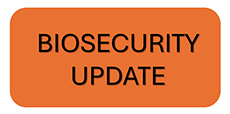Biosecurity Update 14 June 2024

ACTIVITY IN QUEENSLAND
On 19 February 2024, Biosecurity Queensland (BQ) detected a single suspect varroa mite in one of the six sentinel hives at the Port of Brisbane. The sentinel bee hives at the Port of Brisbane are in place as part of a national bee pest surveillance program. The mite was identified as Varroa jacobsoni by the BQ Biosecurity Science Laboratory. The Commonwealth Scientific and Industrial Research Organisation (CSIRO) bee pathology laboratory then confirmed the identification on the 22 February 2024.
On 28 February 2024, during enhanced surveillance, a single Asian honey bee (Apis cerana) nest was found in mangroves at the Port of Brisbane. The whole nest was retrieved and euthanised. Diagnostic results confirmed 37 female V. jacobsoni mites within the Asian honey bee nest. Diagnostics have also confirmed relatedness of these mites to the mite found in the sentinel hive. Genetic testing has indicated this is a new exotic incursion of Asian honey bee. For more information go to the Queensland Government website HERE.
As part of enhanced surveillance a total of fourteen feral European honey bee (Apis mellifera) nests were also found in the mangroves. Twelve of these feral European honey bee nests were euthanised, removed and sent for diagnostic testing to confirm the absence of mites.
Exotic bee virus testing results are negative for six colonies tested to date. Preliminary diagnosis has determined mites are not present in four of the six remaining nests, with final results yet to be reported. Entrances of four of these nests were sampled for eDNA analysis. The remaining two nests won’t be sampled as one has collapsed and disintegrated and the other is inaccessible.
Surveillance is continuing for Asian honey bees at the Port of Brisbane and surrounds to ensure this was the only nest in the area. Testing of hives within the local area is continuing to confirm they are free of varroa mite.
The varroa mites found at the Port of Brisbane are a different species to Varroa destructor, which has been subject to a national response following a detection in NSW in 2022, and which has recently entered a Transition to Management phase.
From 23 May 2024, a movement control order (MCO) covers suburbs within 10 kilometres from the sentinel hives at the Port of Brisbane as a precautionary measure to minimise the risk of varroa mite spread.
All beekeepers in Australia are being asked to inspect their hives regularly for signs of varroa mite and other exotic pests using techniques including the sugar shaker test and alcohol wash. We need to stop the spread. If you are a grower that utilises the services of commercial beekeepers be sure to check that they are aware of these requirements and are compliant.
Sightings of Asian honey bee or varroa mite are required to be reported to the national Exotic Plant Pest Hotline on 1800 084 881. Find out more at the Queensland Government website HERE.
ACTIVITY IN WESTERN AUSTRALIA
On 22 March 2023, the Western Australian Department of Primary Industries and Regional Development (DPIRD) received a report from the Pilbara Port Authority via MyPestGuide® Reporter of suspect exotic bees observed at the Pilbara Ports Authority site in Dampier, WA. After investigations and analysis the bee samples were confirmed to be Apis florea (red dwarf honey bee). A Quarantine Area (QA) surrounding the Burrup Peninsula was established on 5 September 2023 to prevent further spread of the red dwarf honey bee. DPIRD is investigating and managing the response. The department is calling on the State’s beekeepers and land managers to monitor their area for any unusual bees or nests. For more information see DPIRD’s website HERE.
DPIRD Pest and Disease Information Service:
Ph +61 (0)8 9368 3080
Ph padis@dpird.wa.gov.au
This article appears as part of the 14 June 2024 issue of Guacamole, AAL’s enewsletter.
Date Published: 14/06/2024